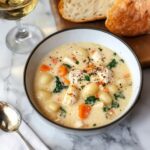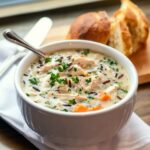Pesto Pasta Salad is a delightful fusion of al dente pasta, fresh vegetables, and the rich flavors of basil pesto. This dish offers a harmonious blend of textures and tastes, making it a versatile addition to any meal. Whether served as a light lunch, a side dish at gatherings, or a refreshing dinner option, Pesto Pasta Salad is both satisfying and easy to prepare.
Full Recipe:
Ingredients
- 1 pound fusilli pasta
- 1 pint cherry tomatoes, halved
- 2 cups fresh arugula
- 1 cup fresh basil pesto
- 8 ounces fresh mozzarella, cubed
- ½ cup grated Parmesan cheese
- ¼ cup mayonnaise
- 2 tablespoons fresh lemon juice
- Salt and freshly ground black pepper, to taste
Directions
- Bring a large pot of lightly salted water to a boil. Cook the fusilli pasta in the boiling water until tender yet firm to the bite, about 12 minutes. Reserve ½ cup of pasta water.
- Rinse the cooked pasta under cold water to cool, then drain well.
- In a large mixing bowl, combine the cooled pasta, cherry tomatoes, arugula, basil pesto, mozzarella, Parmesan cheese, mayonnaise, and lemon juice. Stir to combine.
- If the mixture seems dry, add the reserved pasta water a little at a time until the desired consistency is reached.
- Season with salt and freshly ground black pepper to taste.
- Serve immediately, or cover and refrigerate for up to 3 days.
Nutrients
Per serving:
- Calories: 484
- Total Fat: 14g
- Saturated Fat: 2g
- Cholesterol: 3mg
- Sodium: 1260mg
- Total Carbohydrates: 74g
- Dietary Fiber: 4g
- Sugars: 4g
- Protein: 14g
- Vitamin A: 1326IU
- Vitamin C: 33mg
- Calcium: 122mg
- Iron: 1mg
- Potassium: 346mg
The Origins of Pesto and Pasta Salad
Pesto, a classic Italian sauce, originated in Genoa, Italy. The name “pesto” comes from the Italian word “pestare,” which means “to crush” or “to pound.” Traditionally, pesto was made using a mortar and pestle, where fresh basil, garlic, pine nuts, Parmesan cheese, and olive oil were ground together into a rich, aromatic sauce. Over time, pesto has become a widely popular condiment, often used as a topping for pasta, bread, meats, and even salads.
Pasta salad, on the other hand, is a more modern creation that gained popularity in the United States during the 20th century. As refrigeration became more accessible, cold pasta dishes emerged as a convenient meal option. Combining these two elements—pasta salad and pesto—creates a dish that is both deeply rooted in tradition and suited for contemporary tastes.
Why Pesto Pasta Salad is a Must-Try Dish
There are several reasons why pesto pasta salad is a fantastic dish to add to your recipe collection:
- Bursting with Flavor: The basil pesto provides a strong, herbaceous taste with a creamy texture that coats the pasta perfectly.
- Perfect for Any Occasion: Whether it’s a summer gathering, a picnic, or a quick weekday meal, this dish fits the bill.
- Quick and Easy to Prepare: It requires minimal cooking time, making it an excellent choice for busy individuals.
- Great for Meal Prep: Pesto pasta salad stores well in the refrigerator and often tastes even better the next day as the flavors meld together.
- Customizable: You can easily swap ingredients to fit dietary needs, making it vegetarian, vegan, or protein-rich with simple modifications.
Health Benefits of Pesto Pasta Salad
This dish not only satisfies the taste buds but also provides a variety of essential nutrients. The combination of pasta, pesto, and fresh vegetables offers a balance of carbohydrates, healthy fats, vitamins, and proteins. Here’s a breakdown of the health benefits of the key ingredients:
- Basil Pesto: Basil is packed with antioxidants and essential oils that support immune function and reduce inflammation. Olive oil in the pesto provides heart-healthy monounsaturated fats, while garlic contains compounds that help boost immunity and reduce blood pressure.
- Pasta: Whole wheat or legume-based pasta options can add fiber and protein, making the dish more filling and nutritious.
- Cherry Tomatoes: Rich in vitamins A and C, as well as antioxidants like lycopene, which promotes heart health and skin protection.
- Arugula: A leafy green with a peppery taste, arugula is an excellent source of vitamin K, folate, and calcium, supporting bone health and digestion.
- Mozzarella Cheese: Provides protein and calcium, essential for bone strength and muscle function. For a lower-calorie version, fresh mozzarella or reduced-fat cheese can be used.
How to Customize Pesto Pasta Salad
One of the best aspects of this dish is its adaptability. You can modify it to cater to dietary needs, personal taste preferences, or the ingredients available in your kitchen. Here are a few ideas:
- Protein Boost: Add grilled chicken, shrimp, chickpeas, or tofu for an extra source of protein.
- Dairy-Free or Vegan Version: Swap regular pesto for a dairy-free version by using nutritional yeast instead of Parmesan cheese, and replace mozzarella with avocado or cashew cheese.
- Gluten-Free Alternative: Use gluten-free pasta made from quinoa, chickpeas, or rice for those with gluten sensitivities.
- Nut-Free Pesto: Traditional pesto includes pine nuts, but you can substitute sunflower seeds, pumpkin seeds, or even omit nuts altogether if allergies are a concern.
- Extra Veggies: Toss in roasted red peppers, artichokes, olives, cucumbers, or spinach for added nutrients and variety.
Best Occasions to Serve Pesto Pasta Salad
Pesto pasta salad is suitable for various occasions and meal settings, including:
- Picnics and Outdoor Events: Since it’s served cold, it makes an ideal dish for outdoor gatherings.
- Potlucks and Family Dinners: Its crowd-pleasing flavors and vibrant appearance make it a popular choice.
- Work or School Lunches: It’s easy to pack and holds up well in a lunchbox, providing a refreshing meal option.
- Healthy Side Dish: It pairs well with grilled meats, seafood, or even other vegetarian dishes.
Tips for Making the Best Pesto Pasta Salad
- Use Fresh Pesto: While store-bought pesto works, homemade pesto offers a more vibrant and aromatic flavor.
- Don’t Overcook the Pasta: Slightly undercooking the pasta (al dente) helps maintain texture and prevents a mushy salad.
- Let It Chill: Allowing the salad to sit in the fridge for at least 30 minutes helps the flavors meld together.
- Adjust the Dressing: If the salad seems dry after refrigeration, a splash of olive oil or lemon juice can help freshen it up.
- Mix Right Before Serving: Adding extra arugula or delicate ingredients last prevents them from wilting.
Storage and Shelf Life
Pesto pasta salad can be stored in an airtight container in the refrigerator for up to three days. However, keep in mind that the pasta may absorb the dressing over time, so adding a little extra pesto or olive oil before serving can help restore moisture. Avoid freezing the salad, as the texture of the pasta and vegetables may become undesirable.
Conclusion
Pesto Pasta Salad is a refreshing and flavorful dish that embodies the essence of Mediterranean cuisine. Its combination of fresh basil pesto, juicy tomatoes, creamy mozzarella, and tender pasta creates a satisfying and nutritious meal. Whether you’re preparing it for a quick lunch, a family gathering, or a meal-prep option, this dish is incredibly easy to make and highly adaptable to suit various dietary preferences.
What makes this recipe stand out is its versatility—you can modify it to be vegan, gluten-free, or packed with protein while still maintaining its delicious core flavors. The balance of carbohydrates, healthy fats, and proteins ensures that it is a well-rounded dish that supports overall health.






